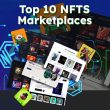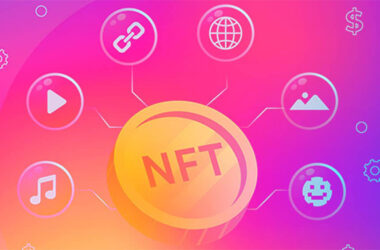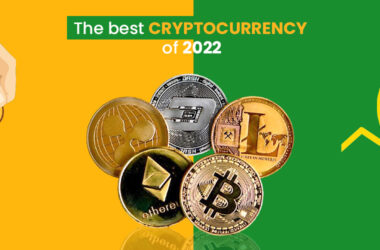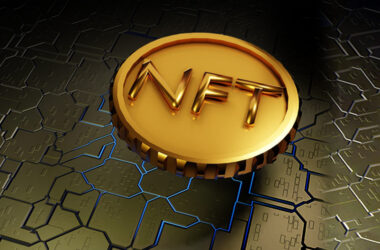NFTs, or Non-Fungible Tokens, have been making headlines recently as a new form of digital asset that can be bought and sold. Essentially, an NFT is a unique digital asset that is verified using blockchain technology.
Think of NFTs like rare trading cards or collectibles, but in digital form. Each NFT is unique and has its own distinct value, making it different from traditional cryptocurrencies like Bitcoin or Ethereum which are fungible, meaning each unit is interchangeable with another.
NFTs can represent a wide variety of digital assets, such as artwork, music, videos, tweets, and even virtual real estate. When someone buys an NFT, they own a digital certificate of ownership for that particular asset. This certificate is stored on the blockchain, a decentralized ledger that verifies and tracks the ownership and authenticity of the NFT.
NFTs are still a new and developing technology, and the market can be volatile. However, they offer creators and collectors a new way to monetize and trade digital assets.
Introduction to Non-Fungible Tokens
Non-Fungible Tokens (NFTs) have become increasingly popular in recent years as a way to represent unique digital assets. Unlike fungible assets, which are interchangeable and have the same value, non-fungible assets are unique and have varying values based on their rarity and demand.
NFTs are built on blockchain technology, which provides a decentralized and secure way to track the ownership and authenticity of digital assets. This means that NFTs can be used to represent various types of digital assets such as art, music, videos, virtual real estate, and even tweets.
When an NFT is created, it is assigned a unique identifier and stored on the blockchain. This identifier provides proof of ownership and authenticity, making NFTs a valuable tool for creators and collectors alike.
The value of an NFT is largely determined by its demand, rarity, and historical significance. Some NFTs have sold for millions of dollars, making them a lucrative investment for those with the means to purchase them.
Overall, NFTs represent a new and exciting frontier in the world of digital assets, providing a unique way for creators and collectors to buy, sell, and own unique digital content.
What is NFTs?
Non-Fungible Tokens (NFTs) are unique digital assets that are built on blockchain technology. They are called “non-fungible” because each NFT is one-of-a-kind and cannot be replaced or exchanged for another asset of equal value. NFTs can represent a wide range of digital content, including art, music, videos, virtual real estate, and more.
Each NFT is assigned a unique identifier that verifies its ownership and authenticity, and this identifier is stored on the blockchain. The blockchain is a decentralized and secure digital ledger that records and verifies all transactions, ensuring that the ownership of an NFT cannot be disputed.
NFTs have become increasingly popular as a way for creators to monetize their digital content, and for collectors to own unique and valuable digital assets. The value of an NFT is largely determined by its rarity, demand, and historical significance, and some NFTs have sold for millions of dollars.
Overall, NFTs represent a new and exciting frontier in the world of digital assets, providing a unique and secure way for creators and collectors to buy, sell, and own unique digital content.
Understanding Tokens, Fungible and Non-Fungible
Tokens are digital representations of value that can be stored, transferred, and traded on a blockchain network. They can be used to represent a wide range of assets, including currency, commodities, digital art, and more.
Fungible tokens are tokens that are interchangeable with other tokens of the same type and value. For example, if you have two $10 bills, you can exchange them for one $20 bill and the value remains the same. Fungible tokens are often used to represent currency, as each unit has the same value as any other unit of the same type.
Non-fungible tokens, on the other hand, are unique and cannot be exchanged for another token of equal value. Each NFT represents a specific, one-of-a-kind asset, such as a digital artwork, a collectible item, or a unique piece of virtual real estate. The value of each NFT is largely determined by its rarity, demand, and historical significance.
NFTs are built on blockchain technology, which provides a decentralized and secure way to track ownership and authenticity of digital assets. This means that NFTs can be used to represent various types of digital assets such as art, music, videos, virtual real estate, and even tweets.
Overall, tokens, fungible or non-fungible, provide a new and exciting way for individuals and businesses to create, exchange, and monetize digital assets.
About NFTs
NFTs, or non-fungible tokens, are digital assets that are unique and cannot be replaced by anything else. They are stored on a blockchain, which is a secure and transparent digital ledger that records all transactions of the asset.
Unlike fungible tokens, such as Bitcoin, which can be exchanged for another unit of the same value, NFTs have distinct characteristics that make them one-of-a-kind. They can represent various forms of digital content, including art, music, videos, and even virtual real estate.
NFTs have gained popularity in the art world, where artists can sell their digital artwork as unique pieces with verified ownership and authenticity. NFTs have also been used in the gaming industry, where players can buy, sell, and trade unique virtual items such as skins and weapons.
The value of NFTs is determined by supply and demand, just like any other asset. Some NFTs have sold for millions of dollars, while others are more affordable. The ownership and transfer of NFTs are secured by blockchain technology, which ensures that the asset is genuine and cannot be duplicated or counterfeited.
NFTs are still a relatively new technology, and there is much debate about their longevity and usefulness. However, they offer a new way for creators and collectors to interact with digital content, and it will be interesting to see how they evolve in the future.
Understand the Game of NFTs
The game of NFTs refers to the buying, selling, and trading of non-fungible tokens, which are unique digital assets that can represent various forms of digital content such as art, music, videos, and virtual real estate.
The game of NFTs involves a market of buyers and sellers who trade NFTs based on their perceived value, rarity, and demand. NFTs are sold through online marketplaces and auctions, where the ownership and authenticity of the asset are verified through blockchain technology.
Like any other asset, the value of NFTs is determined by supply and demand. Some NFTs have sold for millions of dollars, while others are more affordable. The rarity and uniqueness of an NFT can make it more valuable, and the popularity of the artist or creator can also impact the value of their NFTs.
One of the appeals of the game of NFTs is the potential for profit. Investors and collectors can buy NFTs in the hopes that their value will increase over time, allowing them to sell the asset for a profit. However, like any investment, there is also the risk of loss if the value of the NFT decreases.
The game of NFTs is still relatively new, and there is much debate about their long-term value and usefulness. However, they offer a new way for creators and collectors to interact with digital content, and it will be interesting to see how they evolve in the future.
NFTs: A Cryptocurrency
NFTs, or Non-Fungible Tokens, are not a cryptocurrency in the traditional sense. While they are often associated with the blockchain technology that underpins many cryptocurrencies, NFTs are unique digital assets that represent ownership of a specific digital item, such as artwork, music, or collectibles.
Unlike cryptocurrencies such as Bitcoin or Ethereum, which are fungible and interchangeable, each NFT is one-of-a-kind and cannot be replaced by another token. This uniqueness is what gives NFTs their value, as they can represent ownership of rare or exclusive digital content.
While NFTs are often bought and sold using cryptocurrency, they are not considered a type of currency themselves. Instead, they are a way to represent ownership of digital assets in a secure and transparent way, thanks to the blockchain technology that verifies and records every transaction.
So while NFTs and cryptocurrencies share some similarities, it is important to understand that NFTs are a distinct type of digital asset that operate differently from traditional cryptocurrencies.
NFTs Marketplaces
NFT marketplaces are online platforms where people can buy, sell, and trade NFTs. These marketplaces are similar to traditional marketplaces, like eBay or Amazon, but they are specifically designed for NFTs.
Some popular NFT marketplaces include:
- OpenSea: This is currently one of the largest NFT marketplaces, with a wide variety of NFTs available for purchase or sale.
- Rarible: This platform is known for its user-friendly interface and allows creators to mint their own NFTs.
- SuperRare: This platform is focused on high-quality, rare NFTs and has a curated selection of art-focused NFTs.
- Nifty Gateway: This marketplace is owned by the Winklevoss twins and focuses on premium NFTs, including drops from popular celebrities and musicians.
- Foundation: This platform is known for its exclusive, invitation-only access and features a curated selection of high-quality NFTs.
Each marketplace has its own unique features, fees, and requirements, so it’s important to do research and choose the one that best suits your needs as a buyer or seller.
Security of NFTs
NFTs have their own unique security features that ensure their authenticity and prevent fraud. The security of NFTs is based on blockchain technology, which is a decentralized and distributed ledger that records transactions in a secure and tamper-proof manner.
When an NFT is created, it is assigned a unique digital signature that is stored on the blockchain. This digital signature is called a smart contract, which is a self-executing code that contains the rules and conditions of the NFT.
Once the NFT is minted, the smart contract is automatically executed, and the NFT is added to the blockchain.
The blockchain records all transactions related to the NFT, including the ownership and transfer of the NFT. This means that the ownership of an NFT can be easily traced and verified, ensuring that it is not a counterfeit or a duplicate.
Additionally, NFTs can be stored in digital wallets, which are secure online storage facilities that use encryption to protect the NFTs from hacking and theft. These wallets have their own private keys, which are unique passwords that are required to access and transfer the NFTs. It is important to keep these private keys safe and secure, as they are the only way to access and manage the NFTs.
Overall, the security of NFTs is based on the robustness of blockchain technology and the use of smart contracts and digital wallets, which ensure that NFTs are authentic and secure.
Creating, Buying, Selling, and Mining NFTs
Creating, Buying, Selling, and Mining NFTs are important aspects of the NFT market. Let me explain each one of them in a way that grade 2 students can understand.
Creating NFTs:
Just like how you can create a painting or a drawing, people can create digital art that can be turned into NFTs. These digital artworks can be pictures, music, videos, or even tweets. When someone creates an NFT, they are essentially making a digital certificate of ownership for that artwork. This means that they can prove that they are the rightful owner of that digital artwork.
Buying and Selling NFTs:
When you want to buy an NFT, you need to use a cryptocurrency to make the purchase. Cryptocurrencies are like digital money that people can use to buy things online. When you buy an NFT, you are buying the ownership rights to that digital artwork. You can then sell the NFT to someone else if you want to.
Mining NFTs:
Mining NFTs is a little different than mining cryptocurrency like Bitcoin. When you mine an NFT, you are essentially creating a new one. This can happen when you participate in a blockchain network that rewards users for contributing to the network. These rewards can come in the form of NFTs.
Overall, creating, buying, selling, and mining NFTs are all ways that people can get involved in the NFT market. Just like how you can create and trade physical items like toys or stickers, people can create and trade digital artworks as NFTs.
Legal Aspects and Future of Non-Fungible Tokens
Non-Fungible Tokens (NFTs) are a new and rapidly growing area of digital asset ownership, and as such, they are subject to a number of legal considerations. While NFTs are largely unregulated at present, it is likely that governments and regulatory bodies around the world will soon begin to take a closer look at the legal implications of NFT ownership and transactions.
One of the primary legal concerns surrounding NFTs is the issue of intellectual property rights. Many NFTs are created using copyrighted materials, such as artwork or music, and it is unclear whether or not the sale and ownership of these NFTs constitutes a violation of copyright law. Additionally, there are questions about who owns the underlying intellectual property rights to the NFT itself, and whether or not the creator of the NFT has the right to sell or transfer ownership of the NFT.
Another legal issue that arises with NFTs is the potential for fraud and scams. Because NFTs are a relatively new and largely unregulated market, there is a risk that buyers could be taken advantage of by unscrupulous sellers. For example, a seller could create an NFT that purports to be a one-of-a-kind artwork, but in reality, there could be multiple identical copies of the artwork available for sale. This could result in buyers paying inflated prices for what they believe to be a unique and valuable asset.
Despite these legal concerns, the future of NFTs looks bright. As more people become aware of the potential value of NFTs and the market continues to grow, it is likely that governments and regulatory bodies will begin to take a closer look at the legal implications of NFT ownership and transactions. Additionally, the technology that underpins NFTs is likely to improve over time, making them even more secure and reliable as a store of value.
There are still many legal considerations surrounding NFTs, the potential benefits of owning and trading these digital assets are significant. As the market for NFTs continues to grow and evolve, it is likely that governments and regulatory bodies will work to establish clear legal frameworks for NFT ownership and transactions, ensuring that buyers and sellers are protected and that the market remains stable and secure.
Suggestion: HOW TO BUY ETHEREUM
Conclusion
Non-fungible tokens (NFTs) are a new and exciting development in the world of digital assets. NFTs provide a way for artists, creators, and collectors to own and trade unique digital items, such as artwork, music, and video game items, on the blockchain.
Although NFTs are a relatively new concept, they have already made a significant impact in the art world and beyond. NFTs offer a new way for creators to monetize their work, and for collectors to own and invest in unique digital assets.
However, like any new technology, NFTs come with their own set of challenges and risks, such as security and legal issues. It is important to do your research and understand the risks before buying or creating NFTs.
Overall, NFTs have a promising future in the world of digital assets and are likely to continue to evolve and impact the way we think about ownership and value in the digital world.









